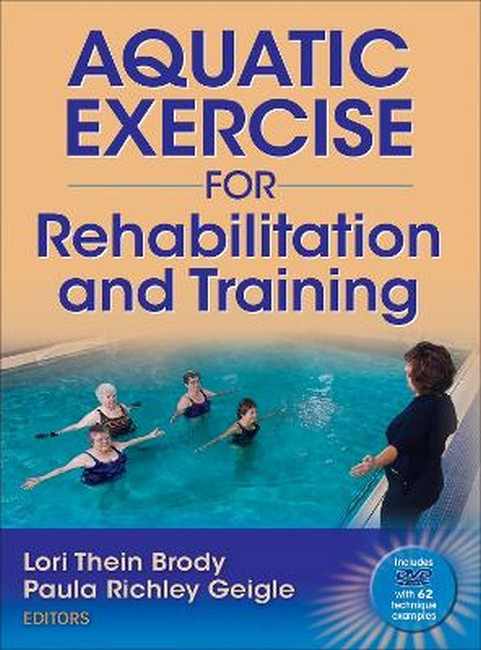Lori Thein Brody, PT, PhD, SCS, ATC, is a senior physical therapist in Madison, Wisconsin. Her aquatic therapy experience includes nearly 20 years of treating a variety of patients. Brody is a frequent contributor to the body of knowledge in rehabilitation, including a popular text on therapeutic exercise, teaching continuing education courses, and providing postprofessional coursework. Brody received the Ron Peyton Award in 2006 for sports physical therapy. In her leisure time, she enjoys swimming, running, biking, and snowshoeing. Paula Richley Geigle, PT, PhD, is an assistant professor in the department of physical therapy and rehabilitation science at the University of Maryland School of Medicine. Geigle's 27 years of clinical practice as a generalist includes aquatic intervention. Part of her research agenda focuses on incorporating aquatic exercise to manage the negative health outcomes of cancer and aging. Geigle is past president of the Aquatic Physical Therapy Section of the American Physical Therapy Association (APTA) and served as coeditor of the Journal of Aquatic Physical Therapy. She received the Outstanding Research Award in 2006 from the Aquatic Physical Therapy Section of the APTA. In her spare time she plays tennis, hikes with her golden retrievers, and reads.
Request Academic Copy
Please copy the ISBN for submitting review copy form
Description
Chapter 1. Introduction and Historical Overview Lori Thein Brody, PT, PhD, and Jean Irion, PT, EdD, SCS, ATC History of Aquatic Healing and Rituals Modern Origins of Aquatic Therapy Current Status of Aquatic Rehabilitation Indications and Advantages of an Aquatic-Based Program Contraindications and Precautions for an Aquatic-Based Program Aquatics programs Summary References Chapter 2. Aquatic Service Providers Charlotte Norton, DPT, MS, ATC, CSCS, and Lynette Jamison, MOT, OTR/L, CPO Lyton Model for the Aquatic Team Licensure, Registration, Certification and Title Acts Function of Each Team Member in the Aquatic Continuum Summary References Chapter 3. Aquatic Properties and Therapeutic Interventions Jean M. Irion, PT, EdD, SCS, ATC Physical Properties of Water Fluid Dynamic Properties of Water Summary References Chapter 4. Physiological Responses to Immersion and Aquatic Exercise Dawn T. Gulick, PT, PhD, ATC, CSCS, and Paula Richley Geigle, PT, PhD Pulmonary System Renal System Musculoskeletal System Neuromuscular System Summary References Part II. Method Elements Chapter 5. The Halliwick Concept Johan Lambeck, PT, and Urs N.Gamper, PT Historical Overview Treatment Classification Halliwick and ICF Learning Stages Function Level Applications Activity Level Applications Participation Level Applications Specific Skill Training Summary References Chapter 6. The Bad Ragaz Ring Method Urs N. Gamper, PT, and Johan Lambeck, PT Physiotherapeutic and Mechanical Principles Proprioceptive Neuromuscular Facilitation Indications Treatment Goals Application of Techniques Treatment Time Exercise Progression Movement Patterns Patterns of the Lower Extremities Patterns of the Trunk Patterns of the Upper Extremities Summary References Chapter 7. Ai Chi Ruth Sova, MS, ATRIC Historical Overview Breathing Patterns Movement Principles Stance and Movement Patterns Ai Chi Benefits Applications in Patient Populations Summary References Chapter 8. Watsu Lynette Jamison, MOT, OTR/L, CPO History and Philosophy Treatment Progression Training and Certification Physiological Effects Psychological Effects Treatment Applications Precautions and Contraindications Summary References Chapter 9. Swim Stroke Training and Modification for Rehabilitation Emily Dunlap, PT Swim Training in an Aquatic Therapy Treatment Plan Swim Training Progression Recovery Skills Static Floating Control Basic Water Safety Skills Swim Training Equipment Swim Strokes and Modification Injury Modifications Summary References Part III. Client Elements Chapter 10. Assessment and Evaluation Paula Richley Geigle, PT, PhD Clinical Decision Making Initial Assessment and Evaluation Medical Clearance Informed Consent Water Safety Screening Vital Sign Baseline Data Documenting Aquatic Programming and Progression Discharge from Aquatic Programming Summary References Chapter 11. Specialized Aquatic Cardiovascular Training Dawn T. Gulick PT, PhD, ATC, CSCS Monitoring Cardiovascular Performance Cerebral Palsy Brain Injury & Stroke Multiple Sclerosis Rheumatoid Arthritis Pregnancy Cardiopulmonary Disease Fibromyalgia Obesity Older Populations Injured Athletes Summary References Chapter 12. Neuromuscular Training David M. Morris PT, PhD, and Paula Richley Geigle, PT, PhD Rehabilitation of Individuals with Neurological Disorders General Guidelines for Treatment Design Aquatic Techniques for Neurorehabilitation Application Balance and Postural Control Aquatic Wellness Programs Summary References Chapter 13. Core Muscloskeletal Training Lori Thein Brody, PT, PhD Functional Anatomy Activities to Improve Mobility Activities to Increase Muscle Performance Core Emphasis Cardiorespiratory Training Specific Exercise Recommendations Summary References Chapter 14. Upper Quarter Musculoskeletal Training Lori Thein Brody, PT, PhD Functional Anatomy Indications for Aquatic Therapy Activities to Improve Mobility Activities to Improve Muscle Performance Upper Quarter Focus Cardiorespiratory Training Specific Exercise Recommendations Summary References Chapter 15. Lower Quarter Musculoskeletal Training Lori Thein Brody, PT, PhD Functional Anatomy Indications for Aquatic Therapy Activities to Increase Mobility Activities to Improve Muscle Performance Cardiorespiratory Training with a Lower Extremity Emphasis Specific Exercise Progressions Summary References Chapter 16. Case Scenarios of Individuals with Specific Needs Paula Richley Geigle, PT, PhD Post Traumatic Brain Injury and Post Partum Depression Child with Spina Bifida Cerebral Palsy with Femur Fracture

